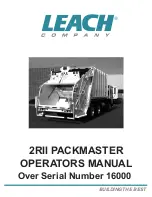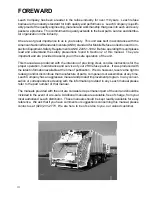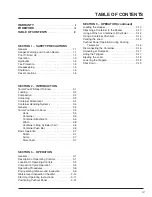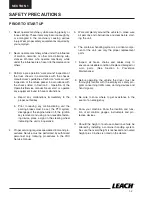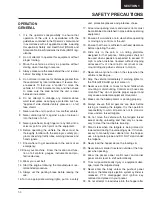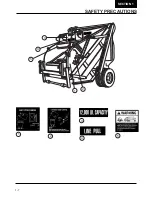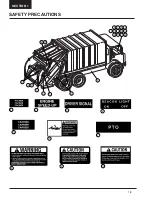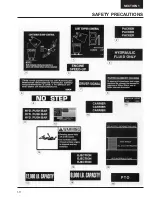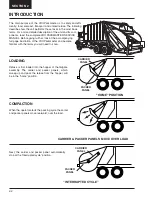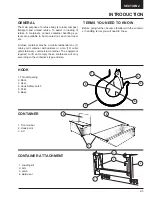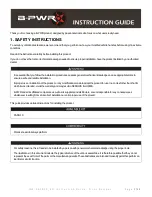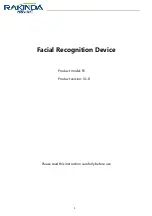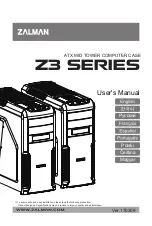
SAFETY PRECAUTIONS
SECTION 1
OPERATION
GENERAL
1. It is the operator’s responsibility to ensure that
operation of the unit is in accordance with the
guidelines contained in the Operator’s manual and
in accordance with all applicable codes including
Occupational Safety and Health Act (OSHA) and
American National Standards Institute (ANSI) reg-
ulations.
2. Do not attempt to operate this equipment without
proper training.
3. Move the vehicle as slowly as possible without
stalling when traveling in reverse.
4. Always make sure the area behind the unit is clear
before traveling in reverse.
5. Do not travel in reverse for distances greater than
those dictated by local ordinances. If reverse trav-
el exceeds 10 feet, use a “spotter” or move the
vehicle in 10 foot increments only, and then check
to make sure the area behind the unit is clear
between increments.
6. Do not attempt to dislodge any material above
waist level unless wearing eye protection such as
“approved” side shielded safety glasses or a full
face shield.
7. Never use the unit to push or tow another vehicle.
8. Never unload uphill or against a pile of refuse or
into the bank of a hill.
9. Never place head, body, fingers or any limbs into a
scissors point or pinch point on the equipment.
10. Before operating the vehicle the driver must be
thoroughly familiar with the employer’s safety pro-
gram concerning traffic rules, warning devices and
hand signals.
11. Know where to get assistance in the event of an
emergency.
12. Know your machine. Know the location and func-
tion of all controls, gauges, instruments and pro-
tective devices.
13. Wear your seat belt.
14. Start the engine following the manufacturer’s rec-
ommended procedure.
15. Always set the parking brake before leaving the
cab.
16. Turn on appropriate warning lights, put on a safety
vest, protective glasses and protective shoes.
17. All service opening covers and access doors must
be maintained and latched in place while operating
equipment.
18. Ensure all co-workers are in view before operating
or moving any controls or the unit.
19. Ensure that there is sufficient overhead clearance
before operating the unit.
20. Ride only in the cab or on riding platforms
designed for that purpose. Riding steps shall not
be used when speeds are expected to exceed 10
mph or when distance traveled without stopping
will exceed
2
⁄
10
of one mile. Do not mount or dis-
mount riding step when vehicle is in motion.
21. Never allow anyone to ride on the steps when the
vehicle is backing up.
22. Stop the vehicle immediately if warning lights for
the TAILGATE AJAR system come on.
23. Never use controls or hoses for hand holds when
mounting or dismounting. Controls and hoses are
movable. They do not provide proper support and
may cause accidental equipment movement.
24. Make sure the backup alarm is working properly.
25. Always ensure that all persons are clear before
raising or lowering the tailgate. It is the operator's
responsibility to warn all persons not to stand or
cross under a raised tailgate.
26. Do not move the vehicle with the tailgate raised
except during unloading and then only as neces-
sary to clear the load before lowering.
27. Stand clear when the tailgate is being raised or
lowered and during the unloading cycle. If it is nec-
essary to manually clear debris from the hopper,
use a long metal probe and DO NOT stand under
the tailgate.
28. Never load the hopper above the loading sill.
29. Never allow material to extend outside of the hop-
per when packing.
30. Allow the packer panel control lever and carrier
panel control lever to shift automatically.
31. To avoid possible bodily injury or equipment dam-
age, lower the tailgate slowly.
32. Never enter the body unless the pushout panel
clamp or the telescopic ejection system cylinder is
released, PTO disengaged and ignition key
removed and placed in your pocket.
33. Do not attempt to load refuse into the hopper after
1-3
Summary of Contents for 2R-II
Page 1: ...2RII PACKMASTER OPERATORS MANUAL Over Serial Number 16000 BUILDING THE BEST...
Page 2: ......
Page 11: ...1 6 SAFETY PRECAUTIONS SECTION 1 1 4 2 5 6 3 7 8 9 10 7 7 9 1 8 4 5 2 6 10 1 3 1 6...
Page 12: ...SAFETY PRECAUTIONS SECTION 1 2 1 3 4 5 1 2 3 4 5 1 7...
Page 14: ...SAFETY PRECAUTIONS SECTION 1 11 12 13 14 15 16 17 18 19 20 21 22 23 1 9...
Page 16: ...SAFETY PRECAUTIONS SECTION 1 1 11...
Page 17: ......
Page 25: ......
Page 27: ...OPERATION SECTION 3 LOCATION OF OPERATING CONTROLS 1 2 3 8 9 10 11 12 7 4 5 6 7 8 3 2...
Page 46: ......
Page 48: ......
Page 49: ......

